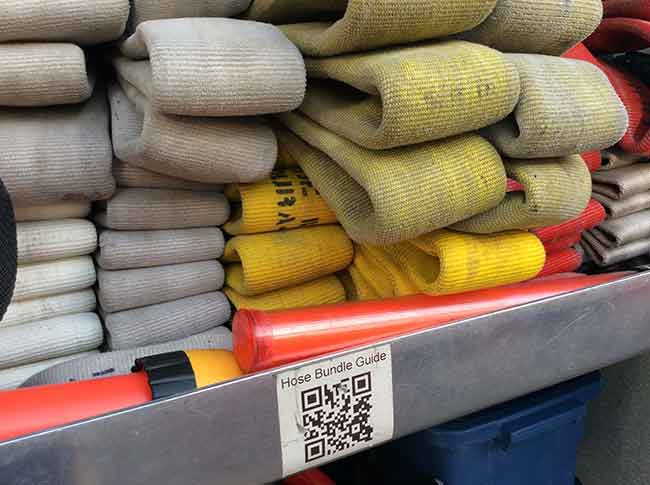
Between alarms – April 2016
Arjuna George
Features Hot Topics Inside The HallEvery once in a while a good spring cleaning is needed to tidy up and declutter our environments. For fire departments, spring cleaning is more than just sweeping and dusting; while it’s important to clean off the shelves, the real purpose of spring cleaning is much more valuable.
 Add QR codes on equipment labels to link directly to a website URL For a fire department
Add QR codes on equipment labels to link directly to a website URL For a fire departmentA spring-cleaning session helps firefighters familiarize themselves with the equipment and gets their hands on the tools. Quite often, some tools are tucked deeply inside a cabinet. Firefighters’ jobs often involve improvising with what we have, and more often than not we can do the job with simple, basic tools. Spring cleaning re-familiarizes firefighters with the equipment and starts their brains working to find more efficient means of preparing for battle.
Once a year, work with your crew to select an apparatus to clean. At Salt Spring Island Fire Rescue, we have turned this idea into a Truck of the Month; each month a scheduled apparatus gets a full strip down and a thorough cleaning.
When spring cleaning an apparatus, start with a 360 size-up much as you would at a house fire. Strip the hose, strip the exterior tools, and expose all the accessories; doing so provides an opportunity to educate the junior members about the tools and how they are best used. Take a moment to discuss and re-evaluate the purpose of each tool. Does the tool still do the job for which it was intended? Is there a better way? Can you do something to make the tool more effective?
Cleaning the truck also provides an opportunity to talk with the crew about hose storage and hose lays. Allow firefighters to brainstorm and discuss best practices and areas that need attention.
The re-evaluation process can bring forward some great ideas for life hacking your tools and equipment. Life hacking is the process of finding ways to use the tools we have to their fullest potentials. Be sure to foster a team approach and allow for ideas to flow.
Once the 360 is complete, begin cleaning in the cab and work your way around the rig. Look at everything with a fresh eye. Challenge the status quo. Over the years our goal has been to reduce the volume of equipment that moves around from cabinet to cabinet. Our continued challenge is to balance the need to keep the cabinets as similar as possible while incorporating new tools and enhancing the storage.
As with every spring clean, give everything a good once over to ensure they are free of dirt, oil and water. When all the tools are out and cleaned, it is a perfect time to pre-rig or life hack your tools. Once again, challenge the status quo and see if there are ways to make your tools more efficient. Seize any opportunity to pre-rig or colour code tools, or make a kit – being well-organized will increase efficiency during those 3 a.m. calls.
Today’s fire service is an all-risk service, which means more tools and equipment are required and have been added to our already packed cabinets. When your team looks at each tool, ask these questions: is this tool still a requirement on this truck? Can it be used more effectively somewhere else? Do we even need the tool anymore? Has the tool been superseded by a better tool – or an all-in-one?
Once you have re-evaluated and possibly culled your tools, find more efficient ways to store those you choose to keep. Take advantage of storage bins, mounting brackets and, of course, labelling. Adding labels helps firefighters quickly locate tools and place them back into service at the end of the call. Oversized labels are highly visible and create a clean professional look. At SSIFR, we are creating graphic icons instead of words to make tool recognition even simpler. Incorporate QR codes into your labels to link directly to a website URL, such as a how-to YouTube video or an online document. We have QR codes on our apparatus cabinets that link to video demonstrations of our department hose bundle and the steps involved in repacking our forestry hose packs.
Once all the tools are cleaned, organized and ready for service, take a digital photo of the cabinet. This photo can be used as a reference to help your members stay on top of the vast number of specialized tools. We also have laminated photo cards hanging inside our cabinets.
Spring cleaning is a training drill just as much as it is a regular maintenance task. The exercise is a great refresher for everyone from the most junior recruits to the fire chief. Get to know your equipment, put hands on it and brainstorm as a team to find ways it can be maximized. It is our job to be prepared when calls come in; this process helps us be even more response ready.
Arjuna George is the acting fire chief of operations on Salt Spring Island, B.C., and has served on the department since 1997. ageorge@saltspringfire.com or twitte@AJGeorgefire
Print this page